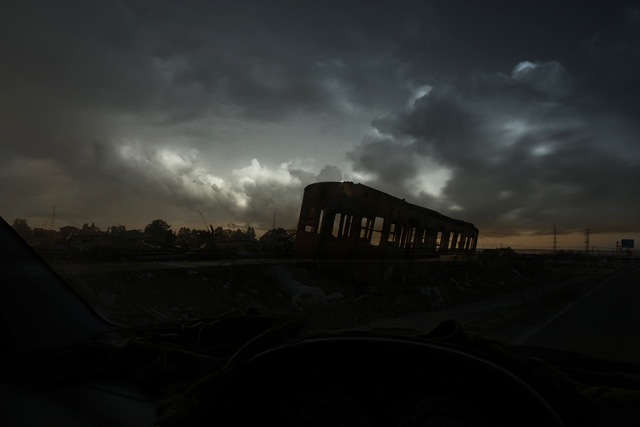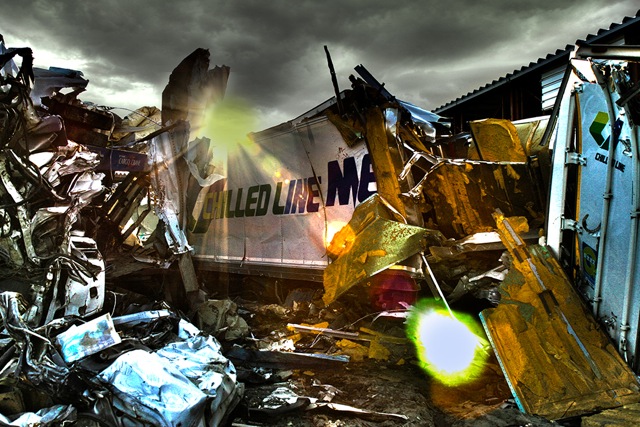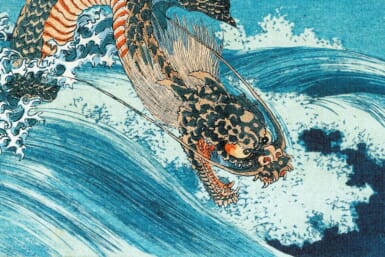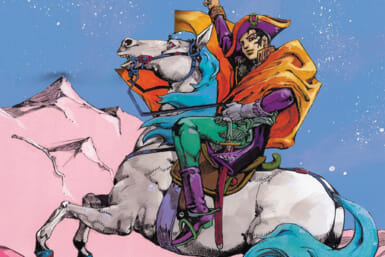On March 11, 2011, Stack Jones was residing in Sendai when the town of Yuriage he was living in was entirely destroyed. During that time he began reporting, and shooting photographs for MSNBC, ABC, and PBS. Subsequently, photographers, and galleries began to show disaster photography, and this made Jones question the morality of turning another’s tragedy into a personal form of art. After looking into the topic, Jones comes to his own conclusion.
By Stack Jones
Main Image: Sendai Route 10. Train And Missing Children.
While preparing a photo gallery for the third anniversary of Japan’s 3.11.11 triple disaster I began to wonder if it was ethical to turn a tragedy suffered by so many into a personal form of artistic expression. To answer this, I needed a clear understanding of what art and ethics actually were. While researching these terms I would also discover the concept known as truth would be equally as important in making that determination.
Ethics is often described as a moral belief system that guides the actions of an individual or group. Truth, The Oxford Dictionary defines as “the quality or state of being true.” Well, that designation was as useless as faithfulness or constancy. The Catholic Church sent Galileo into exile to Siena on The Church’s determination that the world was flat. Historical records more often than not are consistent in putting forth falsehoods as facts. Even Pilate, when considering whether to free or execute Jesus pondered, “What is truth?” Art, as it turns out is even more difficult to define than either of the former.
In ancient times, the creators of art didn’t have access to the technological advances we take for granted today. Those creators didn’t have the ability to produce copies of their intellectual property, and as a result had no means to distribute it. Those ancient masters of expression developed real-time means of sharing their ideas through various forms of communication. Useful forms included illustrations, painting, sculpture and music as a means to express those ideas. Unfortunately, often those expressions were not those of the artist, but of those who held power over them, most notably religious, and political power!
Hugh MacLeod wrote that art suffers the moment others start paying for it. Historically, an artist paid with their life if they portrayed an image, or even a chord structure, in a manner that the powers interpreted as a challenge to their authority. Now, once an artist is paid for their creation, they almost always lose the right to control the final product. Remember Gandhi appearing in Apple Computer advertisements that shamefully shouted “Think Different”? In reality, those images were of Gandhi on a hunger strike protesting the British control of India. Apple, only interested in selling computers, gave no thought to the activist’s message. Clearly, one who retains the rights to a creative work can manipulate not only that image, but the content of that original image as well.
When money interferes with the creative process can that labor still be considered a work of art? If the creative process has been tampered with can it truly be considered a work of art? Bob Dylan, in his essay “Last Thoughts On Woody Guthrie” summed it up:
That run around gallant
And make all rules for the ones that got talent
And it ain’t in the ones that ain’t got any talent but think they do
And think they’re foolin’ you
The ones who jump on the wagon
Just for a while ’cause they know it’s in style
To get their kicks, get out of it quick
And make all kinds of money and chicks
Perhaps Prince said it best: “Let the baker bake the bread.”
When a photographer cleans up an image, or enhances features within that image with a program like Adobe Photoshop, does that new creation represent what had originally been captured? Is it the “captured” image that matters, or what the photographer later settles upon as a final work through the creative process? I’ve spent countless hours removing plastic bags, digital blowouts, white distortion, logos, and even people from an image. Did this manipulation destroy the “art” that existed prior to manipulation? Or did it become art the moment the manipulator considered it complete? Finally, is it the creator that determines if it is art or the audience that it was intended for?
Friedrich Nietzsche said, “We have our arts so we won’t die of truth.” André Gide said, “Art begins at the point where resistance is overcome. No human masterpiece has ever been created without great labor.” What is, therefore, art? The final product, or the work involved in obtaining that end? Perhaps art is the creative process itself—A creation shared by both the artist and the audience.
When I was an artist agent in Hollywood, I represented scores of amazingly talented people. One of my daily duties was to meet with artists who were seeking representation. I looked at thousands of portfolios, and often visited graduate school “art” exhibits. I rarely came across something that moved me. If it doesn’t move us, is it art?
One artist I eventually represented sent me an image of a box that looked like a stack of old eight-track tapes. I deleted that representation query upon receipt. I received it again. I deleted it again. I received it a third time, and due to the tenacity of the artist, I took a closer look, and it turned out to be a Rhino Records commemorative CD case of several Motown greatest hits that had been released during the eight-track tape era. It won a Grammy for best packaging design.
If it offends is it art? U.S. Supreme Court Justice Potter Stewart used a threshold test for obscenity in Jacobellis vs. Ohio (1964). The test was first used in Miller vs. California (1973) where the court held that obscenity could be censored. Jacobellis, the manager of a theater, had been convicted and fined $2500.00 for screening a French film titled The Lovers. The state of Ohio considered it obscene. The three-prong test used considered: 1. Whether an average person, applying contemporary community standards would find the work, taken as a whole, prurient. 2. Whether the work depicts or describes, in a patently offensive way, sexual conduct specifically defined by applicable state law. 3. Whether the work, taken as a whole, lacks serious literary, artistic, political, or scientific value. Justice Stewart viewed the film and determined it was not obscene. In the Court’s majority opinion Stewart wrote, “The Constitution protected all obscenity except hard-core pornography. I shall not today attempt further to define the kinds of material I understand to be embraced within that shorthand description; and perhaps I could never succeed in intelligibly doing so. But I know it when I see it, and the motion picture involved in this case is not that.”
So if we can determine obscenity, or something that offends by simply, “knowing it when we see it,” then perhaps we can understand what art is simply by recognizing it when we see it as well. The problem here is that today we’re surrounded by art, actually bombarded with it as a sales tool, and as a result, we take it for granted. We’ve become blind, numb, or even cynical toward it. This is truly tragic. Or is it?
Greek philosopher Sophocles wrote Oedipus Rex, a tragedy that tells the story of a man who was foreordained to become the king of Thebes. This right, obtained through birth, led Oedipus to murder his father, and eventually marry his own mother. The center of this tragedy is how destiny contributed to Oedipus’ downfall. Would this classic tale have been considered obscene, and therefore not a protected work of art, if the Miller Test had been used during that time? How about the contemporary standards as applied in countries like Saudi Arabia today?
Art in tragedy existed long before modern man walked the face of the earth. The earliest known paintings are petroglyphs that were discovered in Australia, and are approximately 50,000 years old. The most notable original art was discovered in northern Spain and southern France. These cave paintings are more than 15,000 years old.
In the Lascaux caves, artists used animal bones and stones to grind earth pigments in hollows on the floor. The clays were then mixed with water, albumen, animal fat and blood to create complex paints. The paints were then applied with chewed ends of twigs, feathers and animal hair, or smeared and dabbed using the hands and pads from mosses and lichen. They were also applied by blowing paint through reeds and hollow bones. Those people traveled great distances to collect the material necessary to create those works, thereby putting their lives in peril. One can only conclude that expressing thought through painting must have been extremely important to those early earth dwellers. They not only painted the walls and ceilings of caves, but also their tools, clothing and bodies.
There are several theories as to why so much time and energy was expended to create early forms of art. One emphasizes pleasure and a need to tell a story. Another is based on the the possible belief of those ancient people that painting a picture of a successful hunt would help to achieve it. Yet another is that the paintings represented things that were unfamiliar, had mystical powers, and were difficult to communicate to others.
What is truth? Ernest Hemingway, John Lennon and Bruce Lee had one thing in common. All of them were atheists. Moses, Jesus, and Mohammed had one thing in common. They were not!
Today, what is truth to an Israeli is a fairytale to the Palestinians. What’s truth to a Protestant is heresy to a Catholic. Writers of the Talmud sentenced Jesus to an eternal vat of boiling excrement. Likewise, Jesus placed his enemies into an eternal lake of fire. Historical revisionists are ridiculed for demanding educational institutions “rewrite” history in an accurate manner, based on fact, not in the perspective of those that have the most to gain financially, religiously, or politically. On the other hand institutions that make billions by continuing to promote historical fabrications are strictly opposed to change. One thing is certain … If there isn’t a whole lot of truth to be told, there certainly is a lot of creative license regarding it.
Is it possible for art to accurately depict truth? Do movies accurately represent the best-selling book the film had been derived from? Does a documentary film accurately depict opposing arguments of a dispute? No! They’re skewed to the perspective the writer/director wants to convey to the audience, or that of the financial entity producing that work.
In an essay by Leo Tolstoy, titled “What Is Art,” Tolstoy argues against aesthetic theories that define art in terms of good, truth, and beauty. In Tolstoy’s opinion, art was corrupt and decadent, and intellectuals misled the artist who sought their finance, favor and social status.
According to Tolstoy, art must create an emotional bond between the artist and the audience. Tolstoy believed art embraces any human activity. Tolstoy offers as an example a boy who experienced fear after an encounter with a wolf. He later relates that experience, infecting the listener and compelling them to feel the same fear he had experienced. To Tolstoy this is a perfect example of art, as it clearly communicates, is sincere, and is singular and focused on a particular emotion. Tolstoy condemned Wagner and Beethoven as examples of overly cerebral artists who lacked true emotion. Tolstoy wrote that Beethoven’s Ninth Symphony merely pretends at a feeling of unity and therefore is not good art.

Sendai. Ryoh’s Guitar.
An aside: I contacted every major music company offering to deliver new equipment to thirty-seven destroyed schools. None accepted the offer.
Another problem with a great deal of “art” is that it reproduces past models, and as a result it is not properly rooted in a contemporary or sincere expression of the most enlightened cultural ideals of the artist’s time and place. To cite one example, ancient Greek art extolled virtues of strength, masculinity, and heroism, according to the values derived from its mythology. However, Christianity embraces the virtues of the meek and humble. Tolstoy therefore believed it is impossible for modern society to embrace tradition forms of art. He also believed that art should not be considered a means to pleasure or to consider it as one of the conditions of human life. The activity of art is based on the fact that a man, receiving through his sense of hearing or sight another man’s expression of feeling, is capable of experiencing the emotion that moved the man who expressed it. If a man laughs, and another hears it, he becomes merry. If a man weeps, and another hears it, he feels sorrow.
Steven Pressfield in his The War of Art wrote, “To labor in the arts for any reason other than love is prostitution.” Elbert Hubbard wrote, “Art is not a thing—it is a way.” Michelangelo said, “The artist must be the sponsor of thought in whatever endeavor people take on, at every level.”
After years of representing artists, studying “art,” and creating music, lyrics, poetry, stories, illustrations, and photography, I’m still no closer to understanding what art truly is. I can only assert in its simplest form art is subjective, and therefore means something different to everyone. I do believe however that art and tragedy coexist, and that the former could not exist without the latter.
What is art? Art is a tool. It’s an integral extension of tragedy, and it communicates in a manner that the event in and of itself cannot. A true artist does their best to infect our emotions. Sometimes they’re successful at it, and sometimes they fail. Art forces us to look at what we don’t want to see, or believe, and consider alternatives. I think that’s what art’s greatest gift is.
Art is many things to many people. It’s a snapshot of the world in an expressive form perceived by the creator, and conveyed to the audience. Once submitted, the audience determines to accept it as art, or not. If I may borrow a couple of Japanese words, I’d say that art is, dozo—domo, meaning please and thank you. Of these two conditions are met, it is art. Or not!
To see more of Stack Jones’s photography and read about his personal experience while shooting Japan’s worst disaster since experts began keeping record, visit http://stackjones.com/photography.htm.















